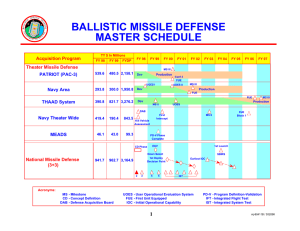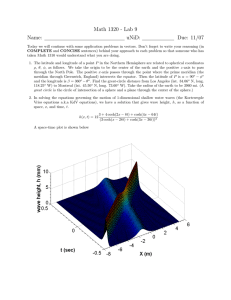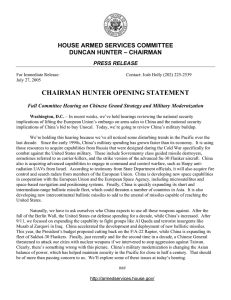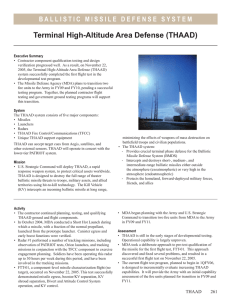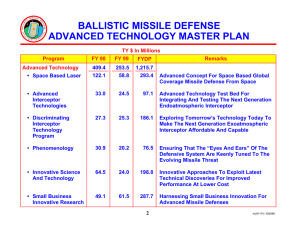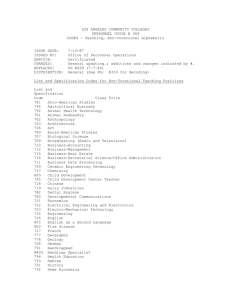BALLISTIC MISSILE DEFENSE Information on Theater High Altitude Area Defense
advertisement
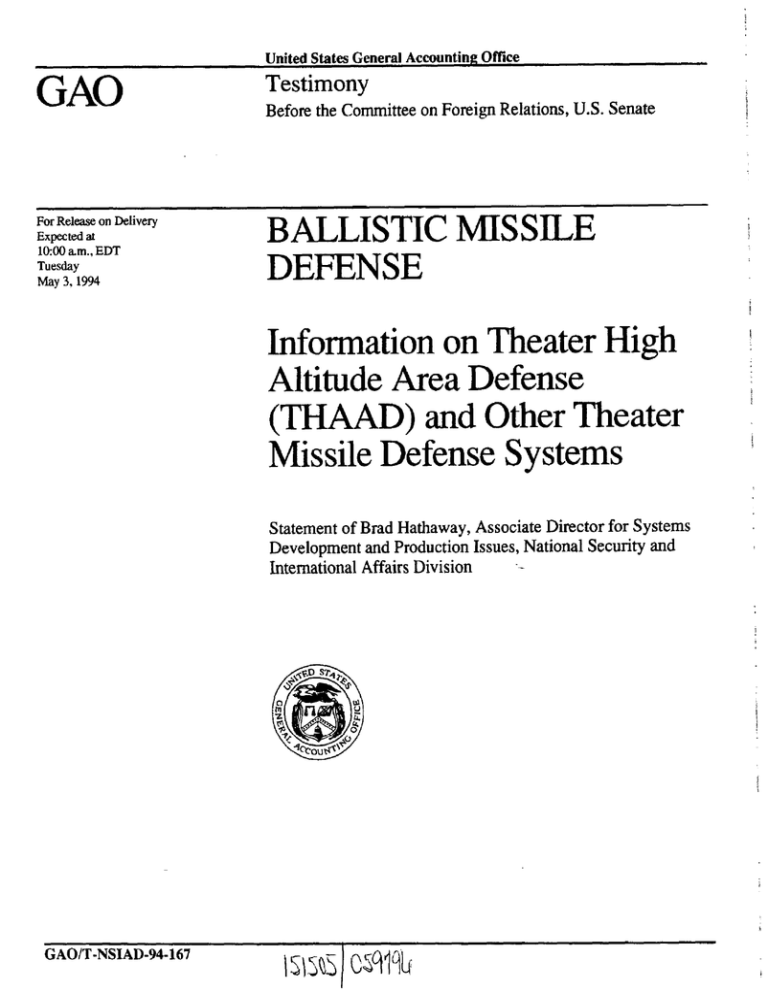
United StatesGeneralAccounting Oftice Testimony Beforethe Committeeon Foreign Relations, U.S. Senate For Releaseon Delivery Expectedat 1O:OO am., EDT Tuesday May 3,1994 BALLISTIC MISSILE DEFENSE Information on Theater High Altitude Area Defense (THAAD) and Other Theater Missile DefenseSystems Statementof Brad Hathaway, Associate Director for Systems Development and Production Issues, National Security and sInternational Affairs Division GAOIT-NSIAD-94-167 -- Mr. Chairmanand Members of the Committee: I am pleasedto be here today to discussthe Theater High Altitude Area Defense(THAAD) systemand other theater missiledefensesystems. We provided you with generalinformation on THAAD in our recent report. ’ To set the stage for your considerationstoday, I will focus on the statusand cost of the theater missiledefenseconceptsand on issuesrelevantto compliancewith the 1972 Anti-Ballistic Missile (ABM) Treaty. THAAD is a mobile, land-basedsystembeing developedby the Department of Defense’s(DOD) Ballistic Missile DefenseOrganization(BMDO). It is intendedto counter theater ballistic missiles at high altitudes and long rangesusing hit-to-kill technology. Such interceptsare deemed desirableto reducethe probability that debris and chemicalor biological agentsfrom a ballistic missilewarheadwill reachthe ground in damagingamounts. Theseinterceptsare to provide protection to wide areassuch as small countries and population centersand to military forces dispersedin a theater of operations. The THAAD systemwill consist of missiles,mobile launchers,ground-basedradars, a tactical operationscenter, and support equipment. The executivebranch is currently involved in discussionsin the U.S.-Soviet StandingConsultative Commissionon a proposal regardingthe ABM Treaty that would allow systemssuch as THAAD to be developedand deployed. The treaty prohibits mobile, land-basedsystemsthat can counter strategicballistic missiles,but it does not define the characteristicsof either a strategic or a theater missile. However, sometheater missilesnow approachthe capabilitiesof the older, shorter range strategicmissilesin terms of maximum range. As a result, the concern is that THAAD, if given the capabilityto counter the newer more capabletheater threats, would have some capability againststrategicballistic missiles. This would have seriousimplicationsfor THAAD and the ABM Treaty. THEATER MISSILE DEFENSE IN THE POST-COLD WAR ERA With the end of the Cold War, the U.S. ballistic missile defensestrategy shifted from defending the nation from a massiveattack by the Soviet Union, to protecting U.S. forces and friends from theater ballistic missileswhile fighting in a major regional conflict overseas. The need for such protection enteredpublic consciousnessduring the PersianGulf conflict. With this shift in strategy, tinding appropriatedby Congressto BMDO for national missile defensedecreasedwhile fimding for theater missile defenseincreased. In fiscal year 1993 Congressappropriatedabout $1.1 billion for theater missiledefenseand about $2.6 billion for IBallistic Missile De e se: Informat’o o T eater Hi& Altitude Area Defense(T’HJ$AD)Svstem, (GAO/N%%94-I gf7gIi January;; 113994;. 1 national missile defense. In fiscal year 1994, however, Congressappropriatedabout $1.6 billion for theater missile defenseand only about $1.1 billion for national missiledefense. A threat of particular concern in this era is the proliferation of theater ballistic missilesarmedwith nuclear,biological, or chemicalwarheads. Ballistic missiledeploymentsare expectedto increase world-wide, despitestepped-upefforts to inhibit their proliferation, and severalcountriesother than the acknowledgednuclear statesare developingboth nuclearweaponsand ballistic missiles. A BMDO-requested 1992 study indicatedthat more than 30 types of guided ballistic missileswith rangesof 30 kilometers or greater were either operationalor under developmentin 19 developing nations. Thirteen countries had produced,or were in the processof producing, missileswith rangesgreater than 300 kilometers. In addition, the number of countriespossessinglonger range (greater than 1,000 kilometers) missileswas expectedto increasesignificantly over the next decade, To addressthis threat, DOD considereda rangeof theater missiledefenseoptions. The DOD’s Bottom-Up Review resulted in a decisionto pursue a theater missiledefenseprogram that includes ------ the Army’s THAAD system, the Army’s upgradedPatriot systemcalled PAC-3 (Patriot AdvancedCapability - Three), the Navy’s seabasedlower tier system, the Navy’s seabasedupper tier system,and an airborneboost phaseintercept system. THAAD, PAC-3, and the Navy’s lower tier are funded as major acquisitionsin DOD’s Future Years DefenseProgram covering fiscal years 1995through 1999. The Nhvy’s upper tier system and the airborne boost phaseintercept systemare being pursuedas concept exploration programs, one of which may enter the demonstration/validationphaseof the acquisitionprocessin fiscal year 1998. I will now provide some additional detailsabout each of the Army, Navy, and Air Force systems. TWO-TIER THEATER MISSILE DEFENSE OPERATING CONCEPT According to program documents,an effective theater missiledefensesystemrequiresa two-tier architecture,with one systemproviding the upper tier of protection and the other system providing the lower tier. Neither system,by itself, can fi.rlfill the total theater missiledefense requirement,which includes defenseof dispersedassetsand population centers. The THAAD systemwould be the upper tier and provides a wide areaof defense,to include coverageof dispersedassetsand population centers. Interceptswill occur either outside the atmosphereor high in the atmosphere. The PAC-3 systemwould be the lower tier, with interceptswell inside the atmosphere,providing defenseof critical assets. 2 This two-tier architecture is designed to intercept threat missiles as far away fkom U.S. forces or allies as possible,maximize the number of intercept opportunities, and minimize the number of ballistic missilesthat “leak” through the defense. However, the two-tier defenseis possibleonly when the THAAD and PAC-3 systems’capabilitiesoverlap. Single-tiercoverageresults when defendingagainstmissileswith rangeseither lessthan the THAAD system’sminimum coverage capability or greater than the PAC-3 system’smaximum coveragecapability. Figure 1 illustrates how the two systemswould work together. Figure 1: Operational Concept of Two-Tier Theater Missile Defense Threat deleclion D 151 intercept 0pportunQ MisslIe commct Figure 1 shows how, in a potential sequenceof operations,an externalearly warning sensor,if available,would detect the target and cue the THAAD systemfor an interceptor Iaunchbefore the ground-basedradar could acquire the target. With or without the externalsensor,the ground-basedradar would eventuallyacquire and track the target. After receiving target identification and guidanceinformation from the radar, the THAAD interceptor would be launchedtoward the target, and a kill assessmentwould be conductedby the radar and tactical operations center. Then, if necessary,a secondTHAAD interceptor would be 3 launched. If the subsequentkill assessmentshowsthat the twget still was not destroyed,the radar would cue the PAC-3 systemto engagethe targetsthat evadedthe THAAD system. THAAD System In 1990, BMDO initiated the THAAD systemrequirementas a hit-to-kill technology demonstrationprogram. In September1992, a 4%month demonstration/validationcontract was awardedto Lockheed. The life-cycle cost estimatefor the THAAD systemis $14.9 billion in then-yeardollars. This amount includes$4.5 billion for developmentbetween1991 and 2001, $5.7 billion for production between 1998 and 2006, and $4.7 billion for operationand support between 1993 and 2016. Thesefigures update the cost that we provided to you last January. With thesefinds, BMDO plans to buy 1,422 THUD interceptors,99 launchers,and 18 ground basedradars. Since each THMD battery would require 150 interceptorsand 9 launchers,these quantitieswould support 8 firing batteries,plus spares. The first THAAD flight test is scheduledfor the last quarter of this year. In 1995, BMDO may exercisean option to buy 40 User OperationalEvaluation Systemmissilesthat would be available for early deploymentin 1996 or 1997 if neededin an emergency. The THAAD systemis scheduledto enter the engineeringand manufacturingdevelopmentphasein 1996, and low-rate initial production is plannedto begin in 1999. The date that the first unit in the field is to be equippedis expectedto be 2001, with full-scaleproduction to begin in 2002. PAC-3 System The original Patriot was a surface-to-airguided missilesystemdesignedt%protect U.S. forces from air strikes. The systemwas initially deployedin Germanyin 1985, and the Army subsequentlyprovided Patriot with the capabilityto defendagainsttheater ballistic missiles. The version currently deployed,referred to as the PAC-2 system,was used in Operation Desert storm. The PAC-3 interceptors, which are under development,will augmentthe PAC-2 interceptors rather than replacethem. When fielded, eachPatriot battery would have a combination of PAC-2 and PAC-3 interceptors. In February 1994, the Army selectedthe ExtendedRange Interceptor (ERINT) as the new PAC-3 interceptor. This selectionmust be approvedby the Defense Acquisition Board. ERINT is a hit-to-kill interceptor offering advantagesin both range and lethality over the PAC-2 interceptor. The life-cycle cost estimateof PAC-3 using the ERINT is estimatedby the Army’s Cost and Economic Analysis Center to be $3.2 billion in then-yeardollars. This amount includes $776 million for development,$1.98 billion for production, and $371 milIion for operation and support. BMDO plans to buy 1,500 PAC3 interceptors,plus a limited number to be used for test 4 I purposes. The first unit is expected,tobe equippedwith PAC-3s by the fourth quarter of fiscal year 1998. NAVY’S TWO-TIER THEATER MISSILE DEFENSE OPERATING CONCEPT The Navy is also developinglower and upper tier systemssimilar to the Army’s However, only the lower tier is currently an approvedacquisition program. If produced,both systemscould be installedon 51 shipswhich have the AEGIS Weapon System. Sea-&d Lower Tier Area DefenseSystem The StandardMissile 2 Block IV is being modified (called Block IVA) to improve its performanceagainstshort-rangeballistic missiles. Its capabilitywill be similar to the Army’s Patriot PAC-3 in terms of defensecoverage. The current cost estimateis $4 billion. BMDO is planningto buy 40 User OperationalEvaluation Systeminterceptorsand two sets of modified sofhvarefor the AEGIS Weapon System. Thesecould be used to equip two shipsin 1997-98. The first ship equippedwith the final systemwould be operationalin 1999. It would be equipped with 20 to 30 Block IVA interceptors. For comparison,a Patriot PAC-3 battery would have 32 interceptors. Sea-basedUpper Tier TheaterDefenseSystem The Navy’s upper tier systemwould have a capability similar to the Army’s THAAD. BMDO is evaluatingseveralinterceptorsfor the upper tier system. The current cost estimateis $4 billion. DOD will decidein 1998whether the program will begin the demonstration/validationphaseof -development. ORNE BOOST PHASE INTERCEPT CONCEPT DOD recently decidedto begin concept exploration activities for an airborneboost phase interceptor system. Such a systemwould consist of an interceptor on Air Force and Navy fighters, such as the F-l 5 and the F-14, that could intercept theater missilesduring their initial boost phasewhile still over enemyterritory. BMDO is currently developingthe plans for this program, which will be submitted shortly to DOD for approval. I will now discusssome issuesthese systemsraise concerningcompliancewith the ABM Treaty. EXW’ESREGARDING ABM TREATY COMPLIANCE Although the ABM Treaty prohibits mobile, land-basedsystemsthat have the capability to counter strategicballistic missiles,it provides no criteria for determiningwhat constitutes a theater or strategic missile. Consequently,the executive branchis currently discussingin the 5 U.S.-Soviet StandingConsultativeCommissiona proposal that, if accepted,would provide a demarcationbetweenstrategic and theater systemsthat would all_owsystemssuch as THAAD to be developedin compliancewith the treaty. Figure 2 illustratesthe nature of the problem that the executivebranch is attempting to resolve. Figure 2: Notional Relationshipof THAAD, PAC-3, and National Missile DefenseSystems rhreat Missiles ‘AC-3 Administration se+ing to changeunderstanding of treaty in this area. 11 L’HAAD Legend: TMD = theatermissiledefense NMD = nationalmissiledefense One of the measuresused for determiningwhether missile defensesystemscomply with the ABM Treaty is the velocity of incoming targets. In other words, if a missiledefensesystemis capable of defendingagainstan incoming warheadwith a velocity greater than a certain speed,the defense systemmay be determinedto be non-compliantwith the ABM Treaty. The velocity of a ballistic missileincreasesas the range of the missileincreases. Sincethe United Statesusesvelocity as a 6 measureof treaty compliance,this measurecan also be relatedto the maximum range of the missilesthat a systemis trying to counter. Some theater ballistic missilesnow approachthe capabilityof strategic missiles. That is, the long-range theater missiles,such as the CSS-2, haveranges(and resulting velocities) that are similar to some of the older, shorter range strategicmissilessuch as the SSN-6. Theseolder, shorter-rangestrategic missilesare obsoleteand are to be out of the Russianinventory by 1996. In the fiscal year 1994 DefenseAuthorization Act, Congressurged the Presidentto immediately pursue discussionson amendingthe ABM Treaty to permit clarification of the distinctions between theater and strategic missiles. The executivebranchis currently seekinga demarcation that would allow systemssuch as THAAD to be developedin compliancewith the ABM Treaty. RESlDUAL CAPABILITY OF THAAD Discussionwith your staff raised questionsabout the extent to which the THAAD system,as currently designed,might have capabilitiesagainsttargetswith velocities abovethose specifiedin the system’sOperationalRequirementsDocument. We havepursuedthis questionwith representativesof the Program Office and the Ballistic Missile DefenseOrganization. It became clear during these conversationsthat any answerto the questionwould be highly dependenton the assumptionsused in modelingthe capabilitiesof the system. i As you receive information from the executivebranchon this question,you may want to assure that it is accompaniedby a clear statementof the assumptionsused. For example,the following characteristicswould have significant impact on the answersderived from modeling: -the operational concept involved, -- the assumedoperationalcharacteristicsof the target vehicle, including its velocity and its ability to alter it’s ballistic path, -- the shapeand location of the protected arearelative to both the target’s and interceptor’slaunch sites, and -- the cueing availableto the systemfrom external sensors. -- Mr. Chairman,this concludesmy testimony. I will be happyto answer any questionsyou or membersof the Committee may have. A (707069) , -- e Ordering Information The fmt copy of each GAO report and testimony is free. Additional copies are 12 each. Orders should be sent to the following address, accompanied by a check or money order made out to the Superintendent of Documents, when necessary. Orders for 100 or more copies to be mailed to a single address are discounted 25 percent. Orders by mail: U.S. General Accounting Office P.O. Box 6015 Gaithedmrg, MD 20884-6015 . . or visit Room 1000 706 4th St. NW (corner of 4th and G Sts. NW) U.S. General Accounting OEPice Washington, DC Orders may also be placed by caEng (202) 512-6000 or by using fax number (301) 2584066. PRWTED~ RECYCLED PAPER United States General Accounting Office Washington, D.C. 20548-0001 Official Pen&y Business for Private Use $300 Address Correction Requested B&Mail Postage & Fees Paid GAO Permit No. GlOO
